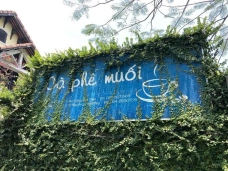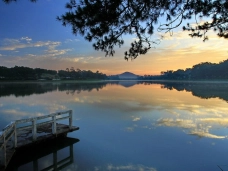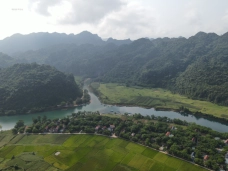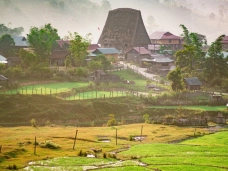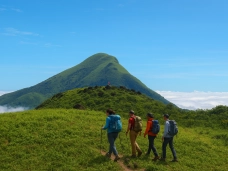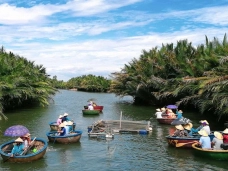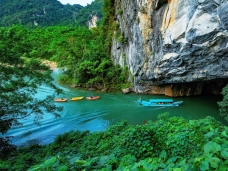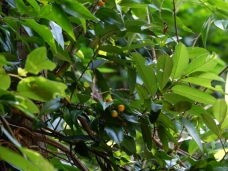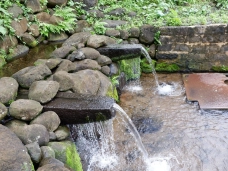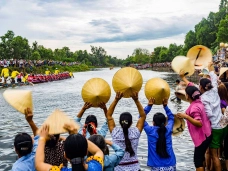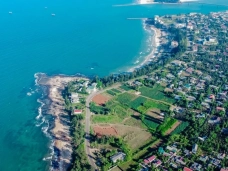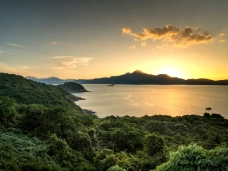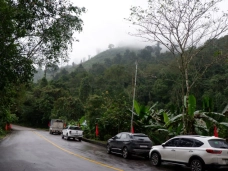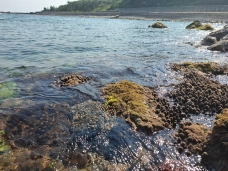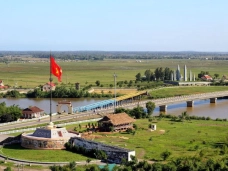Two-Day Adventure in Khe Sanh, Hướng Hóa, Quảng Trị
17-10-2024 16:41
A Journey with Nature
On the morning of September 28, we set off with some local friends from the Khe Sanh Agricultural Tourism team to a hill over 800 meters above sea level for a cloud-hunting adventure. We were lucky—the skies were clear, the fog was light, and the sunshine brightened everything around us. From the top, the view was breathtaking: layer upon layer of mountains stretching out, creating a peaceful landscape. Some peaks stood over 1,500 meters tall, hinting at the ancient geological shifts that shaped this region.
Most of the mountains were covered in soil, with some rocky outcrops standing tall. Hưng, one of our fellow travelers, picked up some sparkling stones—likely sandstone, a type of sedimentary rock. He also found smooth, greenish stones, possibly metamorphic rocks. According to geological studies, this area has undergone long-term tectonic activity, resulting in steep slopes and numerous streams. The region’s formation can be traced back to the late Paleozoic and Mesozoic eras, about 250 to 200 million years ago.
 The landscape from an altitude of 815 meters. Photo by Tue Minh
The landscape from an altitude of 815 meters. Photo by Tue Minh
Climate and Soil
These geological processes have also given rise to the distinct types of soil in the region. Rich red basalt soil covers much of the northern part of Hướng Hóa, especially around the Khe Sanh Plateau and in communes like Hướng Phùng, Tân Liên, Tân Hợp, and Khe Sanh. Alluvial soil, deposited by rivers like the Sê Pôn, can be found along streams and in lowland areas near the Vietnam-Laos border. Higher up, especially in the western and northwestern parts of Hướng Hóa, grey soil on granite bedrock dominates.
The climate here is worth noting. Huy mentioned that Khe Sanh stays cool even in summer, with day-night temperature differences of up to 10 degrees Celsius. During my two-day stay, I soaked in the soothing air and crisp weather, which quickly recharged me after the long journey. The region's climate, largely shaped by its altitude and vegetation, creates a refreshing microclimate, despite being in a tropical monsoon zone.

Cloud hunting at the summit of Huong Tan Moutain. Photo by Tue Minh
Exploring the Western Branch of the Ho Chi Minh Road
As we traveled along the western branch of the Ho Chi Minh Trail, I noticed vast, untouched forests. The dense greenery, filled with large trees and deciduous species, creates a unique landscape, especially during the transition from winter to spring. One striking species is the cinnamon-leafed maple, reminiscent of the maple trees found in temperate zones.
The rich plant life provides a perfect home for wildlife. Locals told us that the area still supports significant populations of red-shanked doucs, white-cheeked gibbons, gaur, bears, wild rabbits, mountain goats, and a variety of bird species. Protecting these natural resources is key to preserving biodiversity and combating climate change.
We also passed by rivers, waterfalls, and reservoirs. The Sê Pôn River, the largest in the region, flows along the Vietnam-Laos border, providing water for agriculture, daily use, and flood control. Streams like La La and Tà Puồng also play vital roles in local irrigation and water supply for the highland communities. Bản Chùa Reservoir, meanwhile, helps regulate water for farming and alleviates drought. Waterfalls such as Tà Puồng and Chênh Vênh, apart from their hydrological value, are also popular eco-tourism spots.
Khe Sanh Coffee
Two factors—soil and climate—play a crucial role in shaping the coffee from Khe Sanh. The area, with an elevation between 400 to 600 meters above sea level, enjoys cool weather and fertile red basalt soil, creating ideal conditions for coffee cultivation. According to Cương, a farm manager in Hướng Hóa, the French first planted coffee here in the 1920s, and traces of those old plantations still remain. Coffee connoisseurs say that Liberica coffee from Hướng Hóa is among the finest in Vietnam.
 Visiting a coffee farm in Huong Phung. Photo by Tue Minh
Visiting a coffee farm in Huong Phung. Photo by Tue Minh
Today, many farms in Khe Sanh grow various Arabica varieties, including Catimor and Catuai. Khe Sanh coffee stands out for its unique flavor. Arabica here is known for its mild aroma, gentle acidity, and lack of bitterness, leaving a refreshing aftertaste. Liberica coffee offers a harmonious balance of rich and light flavors, perfect for those who enjoy high-quality coffee. At the farm, you can savor freshly brewed coffee prepared by the owner—a truly memorable experience.
 Savoring the delicious specialty coffee of Khe Sanh on the hills of Huong Tan. Photo by Huy Vo
Savoring the delicious specialty coffee of Khe Sanh on the hills of Huong Tan. Photo by Huy Vo
Sustainable Agricultural Tourism
Agritourism, a sustainable development model combining agriculture and tourism, supports environmental protection while boosting farmers' income. Khe Sanh - Hướng Hóa, in Quảng Trị province, is an ideal destination for this model, particularly with its high-quality coffee. The cool climate and fertile soil make it perfect for eco-friendly tourism and agricultural experiences.
 We had the opportunity to touch each raw coffee bean. Photo by Tue Minh
We had the opportunity to touch each raw coffee bean. Photo by Tue Minh
Khe Sanh – Hướng Hóa shares similarities with Đà Lạt in terms of climate, but retains a more rustic charm by focusing on traditional farming methods. While Đà Lạt has developed large-scale tourism centered on vegetable and flower farming, Khe Sanh has built its identity around coffee, preserving its natural environment and emphasizing sustainability.
During my time in Japan, through the JICA-funded Co-Creation program, I visited places like Hokkaido, where agritourism integrates high-tech farming with tourism. By contrast, Khe Sanh remains deeply traditional, using minimal technology and maintaining a close connection with nature.

Khe Sanh Valley Farmstay. Photo by Tue Minh
Agritourism is a perfect model for sustainable development, generating stable income for farmers, promoting local products, and protecting natural resources. It also preserves traditional farming methods and cultural values, contributing to environmental conservation. This approach benefits the local economy while offering visitors an authentic and unique experience, setting Khe Sanh apart from more commercialized destinations like Đà Lạt.
Final Thoughts
After two days in Khe Sanh - Hướng Hóa, I realized that this region not only boasts numerous historical sites and rich natural and cultural resources but also holds immense potential for sustainable agricultural tourism. The combination of favorable natural conditions, cultural significance, and agricultural values makes Khe Sanh a truly unique destination. Prioritizing agritourism in its development plans aligns perfectly with global trends and the region's strengths.
By Tue Minh
Comments
Comments (Total 0)
Related Articles
26-11-2025
Khe Sanh – A Journey into Memory
05-11-2025
8 Unmissable Instagram Spots in Da Lat
28-10-2025
Beneath the Arch of Scarlet Blossoms
31-07-2025
Son Tra Awaits
30-04-2025





